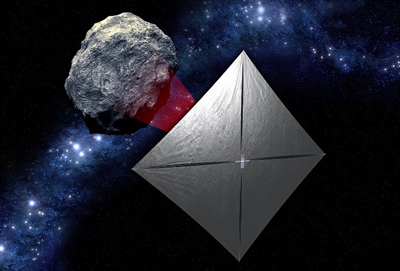Instead of looking at space atmosphere as a toxic vacuum, look at it as an asset, said Les Johnson, who handed a silver 4-inch square of solar sail material as light as small bird’s feather to an audience member. As the piece of sail traveled through a standing-room-only crowd in Jacob’s Believed In Me Auditorium, Johnson explained how huge solar sails could propel a spacecraft using the natural environments of space.

Solar sails use sunlight to propel vehicles through space by reflecting solar photons from a large, mirror-like sail made of a lightweight, highly reflective material. Continuous photon pressure provides propellant-less thrust, potentially enabling a solar sail propulsion system to propel a spacecraft to tremendous speeds – theoretically much faster than any present-day propulsion system and allowing for very high, total-thrust maneuvers for long duration, deep space exploration, Johnson said.
“Solar sails will allow for exploration to be more affordable and will offer access to destinations that are out of our reach,” said Johnson, who delivered a lecture – Solar Sails for Spacecraft Propulsion – sponsored by the Department of Electrical Engineering and Computer Science.
“Solar sail technology is rapidly maturing for space propulsion applications within NASA and may one day take us to the stars,” said Johnson, Senior Technical Advisor for NASA’s Advanced Concepts Office, Marshall Space Flight Center.
In 2008, Johnson, along with New York City College physics professor Gregory Matloff and Giovanni Vulpetti, a Rome, Italy, physicist, published a non-fiction book, “Solar Sails: A Novel Approach to Interplanetary Travel.”
Recognized as an international expert on space systems and advanced space propulsion with focused expertise in solar sails and electrodynamic tethers, Johnson has written four popular science books about space and space exploration, and three science fiction books. He also has served as a technical consultant for the movies Europa Report and Lost in Space. Johnson received his M.S. in physics in 1986 from Vanderbilt. He has received NASA’s Exceptional Achievement Medal three times and has three patents.

In 2018, NASA will launch the Orion spacecraft using the largest, most powerful rocket booster ever built: the Space Launch System. Tucked inside will be 11 CubeSats, self-contained small satellites, each about the size of a shoebox. Once Orion is a safe distance away, the small payloads will begin to be deployed at various times during the flight depending on the particular missions. Orion will proceed toward the moon.
One of the CubeSat missions is the Near-Earth Astroid (NEA) Scout, which will use solar sail propulsion to fly by a small asteroid – known as 1999 VG – taking pictures and making observations. While NEA Scout will probably weigh less than 30 pounds, its sail will spread out to 914 square feet in area. NEA-Scout will perform several lunar flybys before beginning the cruise phase to the asteroid.
Les Johnson is NEA Scout’s principal investigator at Marshall Space Flight Center.
“A solar sail works best when deployed in deep space and SLS will get us there,” said Johnson, “It will take us out of Earth orbit and to interplanetary space – where we need to be to deploy the solar sail. It’s a perfect ride to begin our mission.”
Contact:
Brenda Ellis, (615) 343-6314
Brenda.Ellis@Vanderbilt.edu
Twitter @VUEngineering